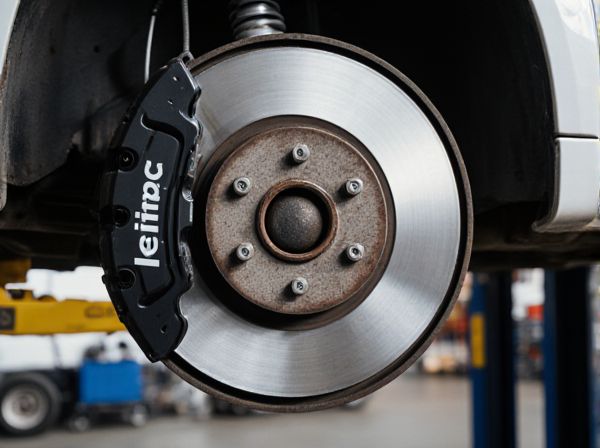
Photo illustration: Organic Pads vs Ceramic Pads
Organic brake pads offer quieter braking and better initial bite, making them ideal for everyday driving and lighter vehicles. Ceramic pads provide superior durability, produce less brake dust, and handle higher temperatures, making them suitable for performance cars and heavy-duty use. Your choice depends on the driving conditions and maintenance preferences you prioritize.
Table of Comparison
| Feature | Organic Brake Pads | Ceramic Brake Pads |
|---|---|---|
| Material Composition | Fibers, resin, and organic compounds | Ceramic fibers, bonding agents, and filler materials |
| Performance | Good initial bite, quieter | High consistent performance, superior stopping power |
| Durability | Moderate wear life | Longer lifespan, resistant to wear |
| Brake Dust | More brake dust, darker in color | Minimal, lighter-colored dust |
| Heat Tolerance | Lower heat resistance, prone to fade under extreme heat | Excellent heat dissipation, less brake fade |
| Cost | Lower initial cost | Higher purchase price |
| Best Use | Everyday driving, light-duty vehicles | Performance vehicles, heavy-duty and daily use |
Introduction to Brake Pad Types
Organic pads, composed of materials like glass, rubber, and resins, offer quieter braking and softer performance suitable for daily driving, although they wear faster under high heat. Ceramic pads contain ceramic fibers and non-ferrous materials, providing superior heat dissipation, longer lifespan, and less brake dust, making them ideal for performance and longevity. Understanding these fundamental brake pad types helps drivers choose the best option based on driving conditions and vehicle requirements.
What Are Organic Brake Pads?
Organic brake pads are composed primarily of non-metallic fibers, resins, and fillers that provide a softer, quieter braking experience compared to ceramic and metallic alternatives. These pads offer excellent initial bite and are less abrasive on rotors, making them ideal for everyday driving with moderate stopping power and reduced wear. Organic brake pads generally produce more dust but tend to be more affordable, appealing to drivers prioritizing comfort and cost-effectiveness over high-performance braking.
What Are Ceramic Brake Pads?
Ceramic brake pads are composed of dense ceramic fibers, nonferrous filler materials, and bonding agents, designed to provide consistent braking performance and reduced noise compared to organic pads. These pads generate less brake dust, which keeps wheels cleaner and improves overall vehicle maintenance. Their durability and heat resistance make ceramic pads an ideal choice for everyday driving and moderate performance demands.
Performance Comparison: Organic vs Ceramic Pads
Organic brake pads offer quieter operation and better initial bite due to their softer composite materials, but they tend to wear faster and generate more dust compared to ceramic pads. Ceramic pads provide superior heat resistance, longer lifespan, and consistent braking performance under high temperatures, making them ideal for aggressive driving and heavy loads. While ceramic pads typically cost more upfront, their enhanced durability and reduced rotor wear contribute to lower maintenance costs over time.
Durability and Longevity
Organic brake pads, composed of materials like glass, rubber, and resins, offer quieter operation but tend to wear out faster due to less heat resistance, resulting in shorter durability and longevity. Ceramic brake pads contain ceramic fibers and bonding agents that provide superior heat dissipation, reducing wear and extending pad life significantly, often lasting up to twice as long as organic pads. The choice between organic and ceramic brake pads directly impacts maintenance frequency, with ceramic pads preferred for their enhanced endurance and consistent performance under high-stress conditions.
Noise and Dust Generation
Organic brake pads produce less noise and generate minimal dust due to their softer compound, which reduces rotor wear and ensures quieter braking performance. Ceramic brake pads create even less dust and operate with near-silent braking, as their hard ceramic materials resist wear and produce fine, non-abrasive dust particles. Noise levels in ceramic pads are typically lower compared to organic pads, making them a preferred choice for drivers seeking quiet, clean braking systems.
Cost Differences: Organic vs Ceramic
Organic brake pads generally cost less upfront, averaging around $30 to $50 per set, making them more budget-friendly for everyday drivers. Ceramic pads, while priced higher at approximately $50 to $100 per set, offer longer lifespan and reduced brake dust, potentially lowering maintenance expenses over time. The cost difference reflects ceramic pads' enhanced performance and durability despite the higher initial investment.
Environmental Impact
Organic brake pads are typically made from natural materials like fibers and resins, resulting in lower heavy metal and toxic chemical emissions during wear and disposal. Ceramic pads contain non-metallic materials such as ceramic fibers, which produce finer, less harmful dust but require more energy-intensive manufacturing processes. Overall, organic pads generally have a smaller environmental footprint due to biodegradable components and simpler production, whereas ceramic pads offer cleaner performance but with higher resource consumption.
Best Use Cases for Each Pad Type
Organic brake pads excel in daily driving and city traffic due to their quiet operation and smooth braking performance, making them ideal for compact vehicles and light-duty use. Ceramic brake pads are best suited for high-performance and heavy-duty applications, such as sports cars and towing, as they offer superior heat dissipation, longer lifespan, and reduced brake dust. Choosing the right pad depends on factors like vehicle type, driving conditions, and maintenance preferences.
Choosing the Right Brake Pad for Your Vehicle
Organic brake pads offer quieter braking and are gentler on rotors, making them ideal for daily city driving and lighter vehicles. Ceramic pads provide superior heat dissipation and longer lifespan, suited for high-performance or heavy-duty vehicles requiring consistent stopping power. Selecting the right brake pad involves assessing driving conditions, vehicle weight, and braking performance needs to ensure optimal safety and efficiency.
 caratoz.com
caratoz.com